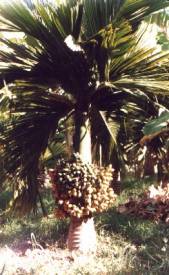|
Arecanut |
|
|
|
|
 |
|
|
ARECANUT GERMPLASM DATABASE
Introduction
The areca palm Areca catechu L. is one of the important plantation crops of India and it is widely cultivated in Tropical Asia. Arecanut, which has been under cultivation for the past any centuries, has attracted the attention of botanist from systematic point of view. The commonly cultivated species in almost all the countries is Areca catechu Linn. It is the source of the common masticatory nut, popularly known as betel nut or Supari. Bentham and Hooker (1883) described the genus Areca as the first one in the family Palmae under the tribe Arecae in their treatise species Plantarum . The genus Areca first identified as a monospecific ( Areca catechu L.) in Linnaeus ' s Species Plantarum (1753) and cultivated widely in tropical Asia. The genus expanded rapidly from its monospecific status and at present it is believed to exist about 76 species. Among these, A. catechu is the only cultivated species, the nuts of which is chewed as a mild stimulant and nuts of a few other species such as A. triandra Roxb. and A. concinna Thw., are also used as a masticatory. Arecanut is cultivated in India over an area of 3.349 lakh ha producing 4.094 lakh tones during 2001-02 with the productivity of 1.22 tonnes/ha. The main pockets of production of arecanut in India are distributed in the states of Karnataka (40 % of area and 44 % of production), Kerala (26 % of area and 21 % of production), Assam (22 % of area and 17 % of production). Other states producing significant quantities of arecanut are Megalaya, West Bengal, Andaman & Nicobar Islands, Andhra Pradesh, Goa, Maharashtra, Mizoram, Tamilnadu, Tripura and Pondicherry.What is Germplasm? Germplasm is the sum total of diversity available in a species which is a pre requisite for genetic improvement programme. Areca genetic resources assembled from various parts of the country and other growing countries serve various needs of Areca researchers, farmers and industrialists. Characterization and documentation of genetic resources is an important step before utilizing the full potential of Germplasm. 
|
|
